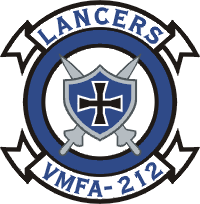
Marine Fighter Attack Squadron 212 (VMFA-212) was a United States Marine Corps F/A-18 Hornet squadron. Most recently known as the "Lancers", the squadron was last based at Marine Corps Air Station Iwakuni, Japan and fell under the command of Marine Aircraft Group 12 (MAG-12) and the 1st Marine Aircraft Wing. VMFA-212 has an extensive combat history having participated in combat operations during World War II, the Korean War, Vietnam War, the Gulf War, and Operation Enduring Freedom. Due to a re-organization within Marine aviation, the squadron was deactivated in 2008.
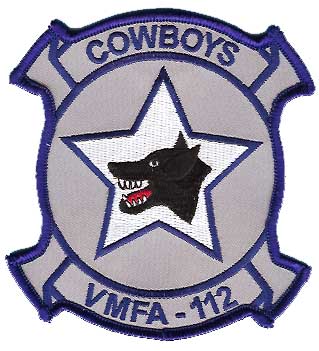
Marine Fighter Attack Squadron 112 (VMFA-112) is a reserve United States Marine Corps McDonnell-Douglas F/A-18 Hornet squadron. The squadron is based at NASJRB Fort Worth, Texas and falls under the command of Marine Aircraft Group 41 (MAG-41), 4th Marine Aircraft Wing. Their tail code is MA. During World War II the squadron saw extensive action throughout the Pacific Theater of Operations especially at the Battle of Guadalcanal as part of the Cactus Air Force. By the end of the war, its 140 air-to-air kills ranked it third among Marine Corps squadrons.

The Curtiss SBC Helldiver was a two-seat scout bomber and dive bomber built by the Curtiss-Wright Corporation. It was the last military biplane procured by the United States Navy. Delivered in 1937, it became obsolete even before World War II and was kept well away from combat with Axis fighters.

Marine Attack Squadron 231 (VMA-231) is a United States Marine Corps fixed wing attack squadron that consists of AV-8B Harrier (V/STOL) jets. The squadron, known as the "Ace of Spades", is based at Marine Corps Air Station Cherry Point, North Carolina and fall under the command of Marine Aircraft Group 14 (MAG-14) and the 2nd Marine Aircraft Wing.

Marine Aircraft Group 41 (MAG-41) is a United States Marine Corps reserve aviation unit based at Naval Air Station Joint Reserve Base Fort Worth, Texas that is currently composed of one F/A-18C squadron, one KC-130J squadron, one C-40 squadron, one Northrop F-5 aggressor squadron based at Marine Corps Air Station Yuma, Arizona, one Marine Light Attack Helicopter Squadron at MCAS Camp Pendleton, one MV-22B squadron based at MCAS Miramar, one aviation logistics squadron and two wing support squadrons with multiple detachments throughout the United States.
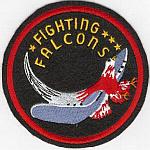
Marine Fighting Squadron 221 (VMF-221) was a reserve fighter squadron of the United States Marine Corps. Originally commissioned during the World War II, it flew the Brewster F2A-3, and after reconstitution in 1943, the F4U Corsair. The squadron, also known as the “Fighting Falcons”, is most notable for its actions on June 4, 1942, during the Battle of Midway, which resulted in 23 members of the squadron, many posthumously, being awarded the Navy Cross for their actions in combat. VMF-221 ended World War II with 185 air-to-air victories, the second most of any Marine Fighting Squadron in the war.

Marine Fighter Attack Squadron 351 (VMFA-351) was a fighter squadron in the Marine Forces Reserve. The squadron was based at Naval Air Station Atlanta and participated in action during World War II and was decommissioned in 1975.
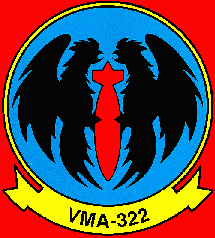
Marine Attack Squadron 322 (VMA-322) was an attack squadron in the United States Marine Corps. The squadron, also known as the “Fighting Gamecocks”, fought in World War II and later became a part of the Marine Forces Reserve based out of Naval Air Station South Weymouth, Massachusetts.

Marine Night Fighter Squadron 544 was a night fighter squadron of the United States Marine Corps that was commissioned during World War II. The squadron flew the F6F-5N Hellcat and although it trained for over a year it never made it into combat. The squadron was deactivated April 20, 1946. To date, no other Marine Corps squadron has carried the lineage and honors of VMF(N)-544.

Marine Fighter Squadron 113 (VMF-113) was a fighter squadron of the United States Marine Corps during World War II and in the Marine Forces Reserve until 1965. Known as the "Whistling Devils", the squadron participated in aerial combat over the Marshall Islands in 1944 and took part in the Battle of Okinawa in 1945. It was decommissioned on April 30, 1947 following the end of World War II but was reactivated in the Reserves a few years later only to be deactivated for the last time in 1965.
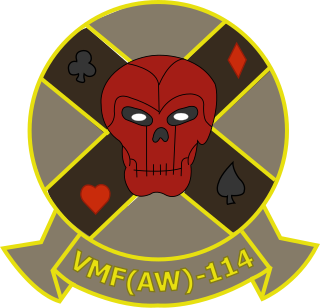
Marine All-Weather Fighter Squadron 114 was a squadron of the United States Marine Corps that was originally commissioned during World War II. Nicknamed the “Death Dealers”, the squadron saw the most action during the war providing close air support during the Battle of Peleliu. The squadron remained on active duty until being decommissioned in 1963.
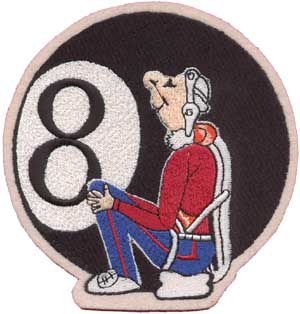
Marine Fighter Squadron 123 (VMF-123) was a fighter squadron of the United States Marine Corps during World War II and later in the Marine Forces Reserve. Known as the “Flying Eight Balls,” the squadron fought at Guadalcanal, Iwo Jima, and Okinawa and served as a training squadron for replacement pilots during the Korean War. The squadron was decommissioned on October 31, 1965 at Naval Air Station Los Alamitos.

Marine Aviation Training Support Group 22 (MATSG-22) is a United States Marine Corps aviation training group that was originally established during World War II as Marine Aircraft Group 22 (MAG-22). Squadrons from MAG-22, were decimated at the Battle of Midway and after reconstituting fought during the Battle of Okinawa. The group was deactivated following the end of the war and were not reactivated until May 1, 2000, when the Marine Aviation Detachment at Naval Air Station Corpus Christi, Texas was renamed MATSG-22.
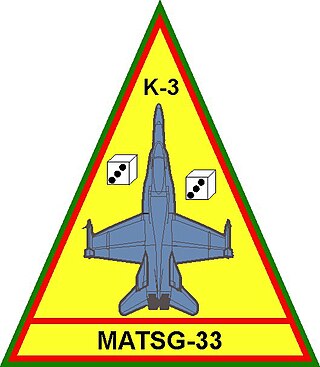
Marine Aviation and Training Support Group 33 (MATSG-33) is a United States Marine Corps aviation training group that was originally established during World War II as Marine Aircraft Group 33 (MAG-33). Fighter squadrons from MAG-33 fought most notably during the Battle of Okinawa and also as the first Marine aviation units to support the Korean War when they arrived as part of the 1st Provisional Marine Brigade. They helped stabilize the United Nations positions during the Battle of Pusan Perimeter and fought in Korea for the remainder of the war. At some point in the 1960s, the group was deactivated and was not reactivated until 2000, when Marine Aviation Training Support Group at Naval Air Station Oceana, Virginia was renamed MATSG-33.
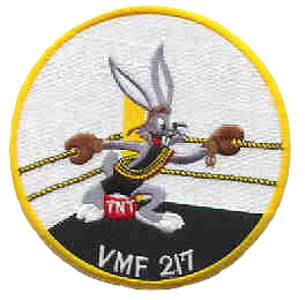
Marine Attack Squadron 217 (VMA-217) was a fighter squadron of the United States Marine Corps that was activated and fought during World War II. Known as “Max’s Wild Hares”, they fought in many areas of the Pacific War including the Battle of Iwo Jima. Following the surrender of Japan, the squadron was deactivated on March 10, 1946. They were briefly reactivated as part of the Reserves but were again deactivated in 1964 and remain in an inactive status today.

Marine Fighting Squadron 215 (VMF-215) was a fighter squadron of the United States Marine Corps that was commissioned and fought during World War II. Known as "The Fighting Corsairs", the squadron fought in many areas of the Pacific War, including the Battle of Bougainville. During its four-and-a-half month tour, the squadron was credited with shooting down 137 enemy aircraft, fourth most in Marine Corps aviation history.
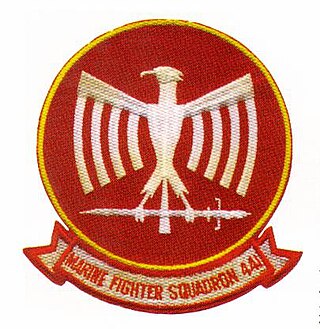
Marine Fighting Squadron 441 (VMF-441) was a fighter squadron of the Marine Forces Reserve during the Cold War. Originally commissioned during World War II, the squadron fought during the Battle of Okinawa. Nicknamed "The Blackjacks", VMF-441 was credited with 49 planes shot during the course of the war. Following the surrender of Japan, the squadron was decommissioned on July 11, 1946. They were reactivated in the Marine Air Reserve and were based out of Naval Air Station Niagara Falls, New York.

Marine Scout Bombing Squadron 244 (VMSB-244) was a dive bomber squadron in the United States Marine Corps. The squadron, also known as the “Bombing Banshees”, fought in World War II in the Pacific Theater as part of the 1st Marine Aircraft Wing. They were deactivated shortly after the end of the war.
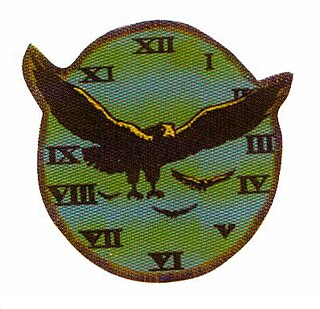
Marine Attack Squadron 543 (VMA-543) was an aviation unit of the United States Marine Corps. The squadron, also known as the “Night Hawks”, were part of the Marine Forces Reserve and were based at Naval Air Station Glenview, Illinois until their deactivation on April 1, 1974. Originally activated during World War II, they fought in the Battle of Okinawa as part of the Tactical Air Force. The squadron was credited with downing 15 Japanese aircraft during the war. Following the surrender of Japan, the squadron was deactivated only to be later reactivated as part of the Reserves. They were again deactivated in 1974 and remain in an inactive status today.




















